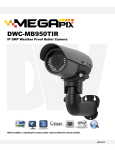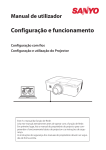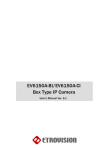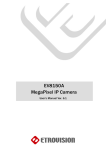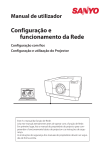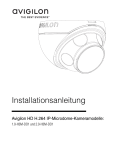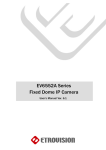Download Benutzerhandbuch CONVISION CC
Transcript
Benutzerhandbuch CONVISION CC-87xx Serie Stand: April 2012 Installationshandbuch Convision Systems GmbH www.convision.com 1 Erläuterungen zum Benutzerhandbuch Das Benutzerhandbuch besteht aus zwei Teilen: 1. Installationshandbuch Im Installationshandbuch-Teil finden Sie die elektrische und mechanische Installation von der Kamera 2. Konfigurationshandbuch Im Konfigurations-Handbuchteil finden Sie die Beschreibung der Benutzerschnittstelle über den Internet-Browser und die Einstellungen der Parameter der Kamera, wie z.B. Videoeigenschaften, Ereignisse, usw. Benutzerhandbuch Convision Systems GmbH Teil 1 Installationshandbuch Megapixel-Netzwerkkamera CONVISION CC-87xx Serie Stand: Januar 2012 Convision Systems GmbH Warnung vor gefährlicher elektrischer Spannung. Zur Wartung befolgen Sie bitte die Anweisungen des Handbuches. INFORMATION - Dieses Gerät entspricht den Richtlinien der Kategorie A für digitale Geräte, gemäß § Teil 15 der FCC- Richtlinien und der CE-Richtlinien. Diese Richtlinien dienen dem angemessenen Schutz gegen schädliche Störung wenn das Gerät in einer kommerziellen Umgebung genutzt wird. Das Gerät kann Hochfrequenzenergie erzeugen. Dies kann bei nicht sachgemäßem Gebrauch schädliche Störungen zu den Funkverbindungen verursachen. Der Betrieb dieses Gerätes im Privatbereich kann schädliche Störungen verursachen. In diesem Fall ist der Benutzer aufgefordert, die Störung auf eigene Kosten zu beheben. WARNUNG VORSICHT : Änderungen oder Abänderungen, die nicht ausdrücklich vom Hersteller genehmigt wurden, unterliegen keiner Garantieverpflichtung. Zur Verhinderung von elektrischen Schlägen oder Feuer: Verwenden Sie keine anderen Energiequellen als angegeben. Setzen Sie das Gerät nicht Regen oder Feuchtigkeit aus Die Installation sollte nur von qualifiziertem Fachpersonal durchgeführt werden! Installationshandbuch CC-87xx Serie 1 Warnung Die Kamera muss regelmäßig gewartet werden. Kontaktieren Sie bitte einen Spezialisten für die Inspektion. Benutzen Sie bitte Ihre Kamera bei einem Defekt nicht weiter Falls Sie Ihre Kamera bei Rauchentwicklung oder Überhitzung weiterbenutzen, kann ein Brand verursacht werden. Installieren Sie die Kamera nur auf einem tragfähigen Untergrund Bei nicht passendem Untergrund kann es zu Verletzungen oder Beschädigungen kommen. Berühren Sie niemals die Stecker mit feuchten Händen Sie könnten einen Stromschlag erleiden. Bauen Sie die Kamera nicht auseinander Es kann einen elektrischen Schlag oder andere Gefahren geben. Die Kamera nicht in der Nähe eines Gas- oder Öllecks benutzen Es könnte ein Feuer entstehen oder andere Gefahren geben. Installationshandbuch CC-87xx Serie 2 Inhaltsverzeichnis 1 Installation von IP-Scan auf einem Windows PC ................................................................................................. 4 2 Basis-Installation der Kamera .............................................................................................................................. 4 3 Konfiguration der Netzwerk Einstellungen ........................................................................................................... 6 4 Zugriff auf die IP-Kamera über das Web-Interface............................................................................................... 6 5 Wiederherstellung der Werkseinstellungen.......................................................................................................... 7 Installationshandbuch CC-87xx Serie 3 1 Installation von IP-Scan auf einem Windows PC Das IP-Scan Programm dient zur Konfiguration von Netzwerkeinstellungen der Kamera. Das IP-Scan Programm steht Ihnen auf CD-ROM zur Verfügung oder Sie können es von unserer Website downloaden unter www.convision.de . 2 Basis-Installation der Kamera Bitte lesen Sie die folgenden Hinweise sorgfältig durch, bevor Sie mit der Installation beginnen. Die nachfolgenden Schritte sind empfohlene Arbeitsschritte zur Installation, es kann aber abhängig von der Installationsumgebung falls nötig davon abgewichen werden. 1. Entfernen Sie die Domeabdeckung von der Kamera. Belassen Sie aber die Schutzfolie auf der Domeabdeckung, bis die physikalische Installation der Kamera abgeschlossen ist. Montieren Sie die Kamera mit Hilfe der beigefügten Schrauben an dem von Ihnen gewünschten Kamera-Standort auf einem ebenen Untergrund. Nutzen Sie dazu die im nachfolgenden Bild mit roten Pfeilen gekennzeichneten Löcher im Kameraboden. Verwenden Sie wenn nötig Dübel. Wenn die digitalen Eingänge und/oder Ausgänge genutzt werden sollen, führen Sie bitte die entsprechende Verkabelung ein und schließen diese an den DI/DO Terminal-Block an. (siehe folgende Abbildung) Installationshandbuch CC-87xx Serie 4 Verbinden Sie das Netzwerk- und die Audio-Kabel. Der Stromanschluss kann direkt an den Power Terminal-Block (12V DC) oder über den DC Power Adapter der Kamera erfolgen. Wenn Sie den Power Adapter nutzen wollen, dann schließen Sie bitte den Adapter-Stecker (siehe unten) an den Power Terminal-Block. ACHTUNG: Vergewissern Sie sich, das positive & negative Terminals korrekt angeschlossen werden, um irreparable Spannungsschäden zu vermeiden Um das Objektiv zu justieren, lösen Sie bitte die Objektiv-Schrauben und justieren anschließend das Objektiv. Drehen Sie danach die Schrauben wieder fest. Schließen Sie die Domeabdeckung wieder und entfernen Sie zum Schluss die Schutzfolie. Installationshandbuch CC-87xx Serie 5 3 Konfiguration der Netzwerk Einstellungen Die Werkseinstellung der IP-Adresse lautet wie folgt: IP Address 192.168.1.2 Subnet Mask 255.255.255.0 Gateway 192.168.1.1 Starten Sie das IP-Scan Programm von der beigefügten CD-ROM und wählen Sie aus den angezeigten Geräten das Gerät mit der IP-Adresse 192.168.1.2, um die von Ihnen installierte Kamera zu konfigurieren. Wählen Sie dann die Taste „Change Settings“, um die Netzwerkeinstellungen Ihrer Kamera zu ändern. Nehmen Sie die gewünschten Netzwerk-Einstellungen vor und drücken Sie auf „Apply“, um die vorgenommen Einstellungen zu übernehmen. 4 Zugriff auf die IP-Kamera über das Web-Interface Wenn Sie die IP-Kamera das erste Mal über die Brwoser-Oberfläche ansprechen möchten oder wenn Sie die IPAdresse geändert haben, werden einige Einstellungen zum ActiveX Control benötigt. 1. Öffnen Sie den Browser des Internet Explorers 2. Geben Sie die IP Adresse in die URL-Zeile ein: http://<IP ADDRESS> (z.B. http://10.1.21.53) 3. Pop-up Fenster und Meldungen zum Download oder zur Ausführung des Active X Controls (Beispiele unten) werden voraussichtlich erscheinen. Wählen Sie immer Installieren oder Ausführen bei all diesen Meldungen aus. Klicken Sie auf die “add-on” Meldung und wählen Sie “Run Add-on” Installationshandbuch CC-87xx Serie 6 Wiederholen Sie die oben genannten Schritte bis alle ActiveX Controls initiert wurden. Sobald dieser Prozess vollständig abgeschlossen ist, wird das Live Bild im IE dargestellt. 5 Wiederherstellung der Werkseinstellungen Es gibt zwei Methoden, die Werkseinstellungen wieder herzustellen. 1. Versorgen Sie die Kamera mit Strom, drücken und halten Sie die Reset Taste für 6 Sekunden lang gedrückt. Die Kamera wird dadurch automatisch auf die Werkseinstellungen zurückgesetzt. (z.B. wird die IP-Adresse auf 192.168.1.2 zurückgesetzt). 2. Über die Weboberfläche über das Setup-Menü (System -> Factory Default); Netzwerkeinstellungen und Benutzerkonten-Daten können vorher gespeichert werden. Bitte sehen Sie in das Firmware User’s Manual und den Punkt Weboberfläche und Funktionalität der Werkseinstellungen. Installationshandbuch CC-87xx Serie 7 Teil 2 CONVISION CC-8xxx Cameras Users Manual Firmware Version 1.0.8 Stand: December 2011 Convision Systems GmbH About This Guide The User’s Manual provides functionality and instructions for the 1080p/5M series. Before Using the IP Camera/Video Server Check the PC requirements Review the OS platform requirements Read an special and import precautionary information Having basic knowledge of network setup and configuration will be helpful Contents 1 2 3 4 5 INTRODUCTION 0 The live view 1 2.1 Setup................................................................................................................................................... 2 Set the Snapshot/Recording Path ......................................................................................................... 3 2.2 Controls and Status............................................................................................................................. 3 2.3 Digital Zoom........................................................................................................................................ 3 2.4 Information .......................................................................................................................................... 4 2.5 Streaming............................................................................................................................................ 4 2.6 Audio................................................................................................................................................... 4 2.7 Control (PTZ Control).......................................................................................................................... 5 setup 6 3.1 System – Information .......................................................................................................................... 7 3.2 System – Generic Setting ................................................................................................................... 7 Camera Name ....................................................................................................................................... 7 System Time.......................................................................................................................................... 8 Digital Input............................................................................................................................................ 8 LED........................................................................................................................................................ 8 HTTP Port.............................................................................................................................................. 9 Language............................................................................................................................................... 9 3.3 System – User Account Management................................................................................................. 9 3.4 System – Maintenance...................................................................................................................... 10 Firmware Update ................................................................................................................................. 10 Export/Import Camera Configuration ................................................................................................... 13 Restore Factory Default....................................................................................................................... 13 Reboot Device ..................................................................................................................................... 13 3.5 System – Local Storage.................................................................................................................... 14 3.6 System – Record Setting .................................................................................................................. 14 3.7 Network – IP Setting ......................................................................................................................... 15 3.8 Network – Streaming......................................................................................................................... 15 3.9 Network – DDNS............................................................................................................................... 16 3.10 Video/Audio – Video Setting ............................................................................................................. 17 TV Out Mode ....................................................................................................................................... 17 Resolution Mode (EV8x80F Models Only)........................................................................................... 18 Profile Setting ...................................................................................................................................... 18 3.11 Video/Audio – Audio Setting.............................................................................................................. 19 3.12 Video/Audio – Color Setting .............................................................................................................. 20 3.13 Event Handle – Event Rule ............................................................................................................... 21 3.14 Event Handle – Event Server............................................................................................................ 22 Email Setting ....................................................................................................................................... 22 Network Storage.................................................................................................................................. 22 3.15 Event Handle – Motion Detection...................................................................................................... 22 3.16 PTZ Control – Serial Setting ............................................................................................................. 23 3.17 System Log – View Log .................................................................................................................... 23 3.18 System Log – Remote Log Setting ................................................................................................... 24 streaming video 25 4.1 RTSP Streaming ............................................................................................................................... 25 Authentication...................................................................................................................................... 26 4.2 Image Snapshot in a Browser ........................................................................................................... 26 Adding a camera to an Nvr 27 5.1 5.2 6 RTSP URL ........................................................................................................................................ 27 Administrator User & Password ........................................................................................................ 28 Firefox 29 1 INTRODUCTION This guide is for the use with the 1080p/5MP series using firmware version 1.0.8. 2. THE LIVE VIEW The IP camera web interface is made up of two main pages: the Live View page and the Setup page. The Live View provides the current display from the IP camera along with selected settings, configuration and functionality. A login is required to access the web UI. The administrator username is “root”, and the password by default is “pass”. After logging into the IP camera via the browser, the user is first presented with the Live View interface. Below is an example of the Live View page. Following the screenshot is a discussion of the different areas within the Live View page. CONVISION CC-8*** Cameras User Manual 1 The right hand panel (Information, Streaming, Audio, Control) can be hidden by clicking the small arrow bordering the video and Streaming pane. Click the arrow (highlighted in green) to hide/display the right side panel. 1.1 Setup In the top right corner of the screen are three links. CONVISION CC-8*** Cameras User Manual 2 Live View: the main viewing screen with various controls. Setup: provides the interface for most of the camera configuration. Path Setup: sets the default Snapshot/Recording path on the PC Set the Snapshot/Recording Path Select Path Setup and then select the directory where Live View will write snapshots/recordings. 1.2 Controls and Status The View Size controls adjust the viewable screen size in Live View. The Zoom feature can be used, and Record and Snapshot will capture video/snapshots to the local hard drive. Digital Out will trigger a digital output signal (e.g. to an alarm). Full Screen will display video in full screen mode. Click the Esc key to exit Full Screen mode. SD Card shows the status of the SD card. Digital In Alert will display when a digital in alert has been triggered. Motion Detection Alert will display when motion detection has been triggered. 1.3 Digital Zoom The Digital Zoom feature allows zooming in on a specific area. When using the View Size controls, a magnifying glass icon will replace the mouse pointer icon. CONVISION CC-8*** Cameras User Manual 3 To magnify a specific area, place the magnifying glass icon over the desired area and left click the mouse. Additional left mouse clicks will continue to magnify wherever the mouse is placed. To zoom out, right click the mouse. If the mouse is moved to the edge of the image window, the mouse icon will change to a white, triangular icon. This icon allows moving the view using electronic PTZ if the functionality is available and enabled. 1.4 Information Resolution and frame rate will be displayed in the Information pane. 1.5 Streaming To toggle between different video streams, use the Stream drop down list. The number of ROI which are enabled in the Video Setting – Profile Setting will determine the number of streams available for viewing. See the “Video Control – Video Setting” section for more information. 1.6 Audio Audio volume controls for speaker and microphone. Clicking on the icon will mute or enable. CONVISION CC-8*** Cameras User Manual 4 1.7 Control (PTZ Control) The PTZ control panel will not be present in those models where PTZ will not be used . Use the Set button to mark a preset, and the Go button to use a preset. CONVISION CC-8*** Cameras User Manual 5 2 SETUP The web interface is made up of two main pages: the Live View page and the Setup page. The Live View page interface was introduced in the previous section. The Setup interface is primarily used for viewing and configuring the IP camera’s settings. From the Live View page, click the Setup link at the top right side: The left hand panel lists the configuration nodes which can be viewed and modified. Clicking on an item will reveal sub menus which are available. To return to the Live View page, click the Live View link in the right hand corner. CONVISION CC-8*** Cameras User Manual 6 NOTE: Configuration changes in the Setup interface require clicking the SAVE button. Otherwise, changes will not be applied. The following discusses the different basic configuration options within the Settings page. 2.1 System – Information The Information page is always the initial page displayed when switching to the Setup view. Basic information related to the IP camera is displayed here. The page only displays information; no changes can be made here. 2.2 System – Generic Setting Camera Name CONVISION CC-8*** Cameras User Manual 7 Enter a camera name if a specific name is desired. System Time 3 options are available: Manual: insert time manually PC Time: set to the current PC time Network Time Server: periodically synchronizes with a time server For Network Time Server two standard options are provided. If another time server is preferred, then choose others from the list and add the address of the time server which will be used. Renew Period specifies the synchronization schedule. Digital Input This defines the method by which the digital in sensor operates. If the normal condition is open (N.O.), then the alarm will be triggered when the circuit is closed. The opposite applies for N.C. LED The camera LED lights can be enabled or disabled. CONVISION CC-8*** Cameras User Manual 8 HTTP Port To use a non-default web server port, change the HTTP Port value. Language Currently English, Simplified Chinese and Czech are available. 2.3 System – User Account Management User accounts can be added, edited or deleted via the controls in the left corner. Users are assigned to a group (admin, operator or viewer). CONVISION CC-8*** Cameras User Manual 9 To edit or delete an account, highlight the account in the User List window and click the edit/delete button. After making changes, click SAVE to apply changes. 2.4 System – Maintenance Firmware Update The firmware can be upgraded using the web UI or an SD card. After upgrading, the ActiveX controls and browser cache should be cleaned to prevent old controls & pages from being used. Web UI Firmware Upgrade IP and User Account settings can be preserved by checking the appropriate boxes. After selecting the new firmware file, click Update to proceed. Messages that the camera is upgrading and rebooting will follow during the upgrade. CONVISION CC-8*** Cameras User Manual 10 Perform the steps in “Clean the ActiveX and IE Cache & History” below, using Etroscan change the network settings (if applicable), then check the System Information page to verify the upgrade has been completed successfully. Upgrade using SD Card The SD card should be empty of any existing files before proceeding. Rename the firmware file to ev-fw.bin, and copy the file to the SD card. Insert the card into the camera’s SD card slot. Power on the camera, and wait about 1 minute. The green power LED will flash quickly during the upgrade, become stable briefly and slowly blink while performing a reboot. Check EtroScan to verify the camera is available (IP address may have changed to factory default, 192.168.1.2). Remove the SD card. After web UI access is once again available, review the System Information page to verify the upgrade has completed successfully. Clean the ActiveX and IE Cache & History After upgrading, the ActiveX controls and IE cache & history should be cleared to prevent old pages and controls from being used. Close all instances of IE and open 1 IE window. In the right corner, select Tools->Manage Addons In the Manage Add-ons window, select “All add-ons” CONVISION CC-8*** Cameras User Manual 11 Scroll down and find one of the ActiveX controls, and click the More Information link. In the More Information window, click Remove to clear the ActiveX control from IE. Repeat this for the remaining ActiveX components. CONVISION CC-8*** Cameras User Manual 12 To clear the cache and browsing history, in the IE menu select Tools->Internet Options. Click the Delete button in Browsing History. Export/Import Camera Configuration Export will save the camera’s configuration settings to the PC in an archive file. To import, first use Browse to select a camera’s exported configuration file. Next click Import to proceed with replacing the current camera settings with the settings in the configuration file. Restore Factory Default Replaces factory default settings via the web UI. Network and/or user account settings can be saved if the corresponding check boxes are selected. Reboot Device CONVISION CC-8*** Cameras User Manual 13 2.5 System – Local Storage Format will format the card. Note: contents of the SD card will be lost. Double click on folders to go up/down a directory level. 2.6 System – Record Setting When recording is done via event triggers, Record Setting will define how the recording is performed. Record Stream Profile will only display currently enabled streams. CONVISION CC-8*** Cameras User Manual 14 2.7 Network – IP Setting Select DHCP or Static IP for the camera. If using static, then enter the appropriate settings for your environment. Please confirm all network related settings with the network administrator prior to making any changes. 2.8 Network – Streaming CONVISION CC-8*** Cameras User Manual 15 The port settings all relate to camera ports. If streaming outside of a LAN (e.g. to the internet), then routers on both the camera and client side need to provide necessary access for these ports. Video and audio server ports only need be changed if a network has security or operational restrictions using these ports. In most cases, the RTP/RTCP video and audio should use the default values. While the RTP/RTCP audio/video ports by default are 6002-6005, this represents the starting point for client connections. If 1 client is connected, then this connection would use 6002-6005, but a 2nd connection would then use 6006-6009. This may require proper router configuration if using the web UI outside of a LAN. Maximum Viewers refers to concurrent uses. Connections beyond this value will receive an error upon connection. Multicasting allows sending a message or data to a group via a single message. The multicasting parameters are only for configuring a camera to use multicasting. A networking environment that supports multicasting must be setup which is beyond the scope of this document. 2.9 Network – DDNS DDNS is used to map a dynamically assigned IP address (a device using DHCP) with a hostname. NOTE: Certain network configuration will likely be required (i.e. mapping the IP address recognized by the DDNS service to the IP camera) to implement DDNS. Therefore, the network administrator will likely need to be consulted. If the IP camera uses DHCP, a DDNS service can provide a hostname for use with the IP camera. Registration with one of the DDNS service providers (ddns.nu, dyndns.org) is required for use of this feature. CONVISION CC-8*** Cameras User Manual 16 2.10 Video/Audio – Video Setting Deflicker can be adjusted if flickering is present due to artificial lighting. This setting should be set to match the utility frequency for a given country. TV Out Mode TV Out Mode can be enabled with SDTV or HDTV options available. SDTV = CVBS output HDTV = YPbPr output When TV Out Mode has been enabled, 2 video profiles will be enabled. Profile 2 will change to settings which will be used for the video out display (e.g. D1 resolution). Profile 1 settings will not be modified. CONVISION CC-8*** Cameras User Manual 17 Resolution Mode (5 MP Models Only) For the 5 MP model series, Resolution Mode provides a variety of resolution formats. 5M will change Stream 1 to 5M (2592x1920) with a maximum 10fps for both Stream 1 and 2. The 5M option limits ROI to 2, and recording via the camera (e.g. SD card) is disabled. Minilux mode uses noise cancelation technology to provide clearer image quality in low lux conditions. Profile Setting The Video Profile Settings control the ROI (Region of Interest) characteristics. The ROI video is streamed via RTSP protocol. See the “Streaming ROI” section for more on viewing ROI video. The number of available ROI profiles for viewing can be set by selecting the appropriate option button. 4 Profile defines each stream with a VGA resolution (640x480), while 1 Profile and 2 Profile settings provide some options for resolution. Setting for specific ROI profiles can be found in the Video Quality Setting section. ROI profile 1 & 2 are preconfigured profiles which have some settings that are configurable (e.g. FPS). All profiles offer Constant Bit Rate (CBR) or Variable Bit Rate (VBR) mode. CONVISION CC-8*** Cameras User Manual 18 The GOP (Group Of Pictures) can also be adjusted. The GOP is based on the FPS setting. For example, if the FPS is 20 and the GOP setting is 2, then the GOP is 40 frames. A GOP is comprised of one I frame and the remainder is P frames. 4 Profile defines each stream with a VGA resolution (640x480). In the Region Size settings, the image has a mask covering area that will not be displayed; the lighter shaded area will be what is displayed for the ROI. To adjust the ROI, click & drag the window or click within the masked area to reposition. 2.11 Video/Audio – Audio Setting CONVISION CC-8*** Cameras User Manual 19 Select the desired audio codec. The Bitrate is configurable for some codecs. 2.12 Video/Audio – Color Setting Brightness Contrast Saturation Sharpness Flip: flip horizontally (top to bottom) Mirror: flip vertically (right to left) AE Range Limit: enabling exposes an upper/lower limit list of exposure values for configuration Enabling also disables AEC & AGC settings and hides the setting controls AEC: Automatic Exposure Control; disabling enables Manual Exposure Max Exposure: maximum possible exposure time Manual Exposure: sets specific exposure time AGC: Automatic Gain Control; disabling enables Manual Gain Max Gain: maximum possible gain Manual Gain: sets specific gain setting AWB: Auto White Balance Deflicker BLC: Back Light Compensation; image EV (Exposure Value) can be increased to compensate for background lighting WDR: Wide Dynamic Range Noise Filter: image noise compensation; manual allows user to define level of noise reduction (0 none; 254 max). While noise reduction will smooth pixilation (usually in dark areas), too much may result in blurring. IR-Cut Filter: controls IR filter operation B/Win night mode: deselect if black & white not desired in night mode CONVISION CC-8*** Cameras User Manual 20 2.13 Event Handle – Event Rule The Event Rule page is used to define actions (e.g. record to SD card) in response to the triggering of an event (e.g. motion detection). The Add/Update rule screens contain the same fields. Rule Name is a user defined name for a user defined trigger/action. A trigger or action may require additional settings (e.g. motion detection area). Period Time is a time interval during which an event can not be triggered. For example, if Period Time is set to 60, then after a specific event is triggered (e.g. motion detection), that event can only be triggered after 60 seconds. This applies only to a user-defined event. If 2 motion detection events have been configured (e.g. MD1 and MD2), then if MD1 is triggered, MD2 can still be triggered regardless of MD1’s Period Time setting. Be sure to click SAVE in the main Event Rule screen to save any changes. CONVISION CC-8*** Cameras User Manual 21 2.14 Event Handle – Event Server The Event Server page has configuration options for event notification via email and event driven video/images to network storage. Email Setting Enter the SMTP server for Server Address and all additional relevant details. The username may only contain alphanumeric characters and the underscore character, “_”. Network Storage NFS and Samba are supported; if enabled then input relevant details. 2.15 Event Handle – Motion Detection To use motion detection, motion detection should be enabled and at least one motion detection area enabled. Checking the box for an Area (e.g. Area 1) enables it. CONVISION CC-8*** Cameras User Manual 22 To modify a Detect Area, select “Draw” and click & drag to resize the detection area (light area) or specify coordinates (X, Y, W, H). X=horizontal, Y=vertical, W=width, H=height. 2.16 PTZ Control – Serial Setting PTZ settings can be applied if the camera will interact with a PTZ device. Pelco P and D are supported as well as RS-485 and RS-422 communication modes. Please refer to the PTZ device’s required settings to configure the web UI PTZ settings. 2.17 System Log – View Log The System Log displays system and event details. CONVISION CC-8*** Cameras User Manual 23 The System Log has information specifically related to basic system messages (e.g. startup, shutdown) while the Event Log contains information related to events triggered. 2.18 System Log – Remote Log Setting The System and/or Event log data can also be remotely logged. Check the box to enable and provide the corresponding log server address. CONVISION CC-8*** Cameras User Manual 24 3 STREAMING VIDEO 3.1 RTSP Streaming Video can be streamed to a video player (e.g. VLC) via RTSP protocol using the standard RTSP port number 554. The URL is in the following format: rtsp://[IP ADDRESS]/rtpvideo[1-4 or 1-8].sdp Replace with the appropriate IP address. rtpvideo1-4 represent video profiles with different characteristics. For more information on video profiles, see Video/Audio – Video Setting”. Using VLC for example, select Media from the menu bar and Open Network Stream. Next specify IP address of the camera and stream profile. Click Play and video will begin streaming in the video player. WARNING: firewalls and other network security may prevent video streaming. CONVISION CC-8*** Cameras User Manual 25 Authentication If Streaming authentication has been enabled in Network -> Streaming Then a username/password must be supplied with the RTSP URL rtsp://USERNAME:PASSWORD@[IP ADDRESS]/rtpvideo[1-4].sdp 3.2 Image Snapshot in a Browser To view an image snapshot in a browser, the jpeg.cgi call will provide a VGA snapshot. http://<IP ADDRESS>/config/jpeg.cgi CONVISION CC-8*** Cameras User Manual 26 4 ADDING A CAMERA TO AN NVR The following gives some basic guidance for adding CONVISION MP cameras to an NVR system that supports RTSP streaming. Please refer to the NVR instructions for specific details on how to add and administer cameras for the NVR system. When adding a camera to an NVR, the NVR will likely require 3 configuration parameters from the camera: An RTSP URL An HTTP Port Number The administrator username and password 4.1 RTSP URL The RTSP URL will likely be the Profile 1 stream from the camera which by default will be in the following format: rtsp://[IP ADDRESS]/rtpvideo1.sdp This assumes that the default port, 554, is being used, the “rtpvideo” access name is defined, and camera profile stream 1 is being used. Below is the Stream Setting page which defines the RTSP port and the Access Name. If the Access Name and/or RTSP Port have been changed, then specify the RTSP URL in the following format: rtsp://[IP ADDRESS]:[PORT#]/[ACESSNAME]1.sdp If “rtpvideo” was changed to “ev”: rtsp://10.1.21.138:555/ev1.sdp CONVISION CC-8*** Cameras User Manual 27 The camera can be configured with multiple independent streams. The Video Settings page lists information related to the different profile streams. To assign a specific profile stream to the NVR, then append the appropriate profile number to the access name: rtsp://[IP ADDRESS]/[ACCESSNAME][PROFILE#].sdp example: rtsp://10.1.21.38/rtpvideo3.sdp 4.2 Administrator User & Password The administrator username is “root” and the default password is “pass”. CONVISION CC-8*** Cameras User Manual 28 5 FIREFOX While there is support for Firefox, the Live View interface will not have many of the controls available in IE. These controls are implemented using ActiveX which is only supported by IE. CONVISION CC-8*** Cameras User Manual 29














































